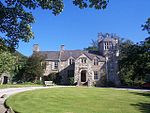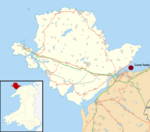Aber railway station (Gwynedd)
1848 establishments in Wales1960 disestablishments in WalesAbergwyngregynDisused railway stations in GwyneddFormer London and North Western Railway stations ... and 4 more
Pages with no open date in Infobox stationRailway stations in Great Britain closed in 1960Railway stations in Great Britain opened in 1848Use British English from March 2015

Aber railway station was a railway station on the North Wales Coast Line in the Welsh county of Gwynedd. Although trains still pass on the main line the station closed in 1960. A signal box on the site remained in use until the installation of colour light signalling.
Excerpt from the Wikipedia article Aber railway station (Gwynedd) (License: CC BY-SA 3.0, Authors, Images).Aber railway station (Gwynedd)
Station Road,
Geographical coordinates (GPS) Address Nearby Places Show on map
Geographical coordinates (GPS)
| Latitude | Longitude |
|---|---|
| N 53.2387 ° | E -4.0226 ° |
Address
Station Road
LL33 0LB , Aber
Wales, United Kingdom
Open on Google Maps






